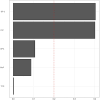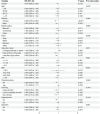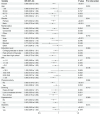Association between urinary exposures and the risk of chronic obstructive pulmonary disease in smokers: results from NHANES 2007-2016
- PMID: 40255370
- PMCID: PMC12006094
- DOI: 10.3389/fpubh.2025.1548401
Association between urinary exposures and the risk of chronic obstructive pulmonary disease in smokers: results from NHANES 2007-2016
Abstract
Objective: This study aims to shed light on the connection of urinary exposures with risk of chronic obstructive pulmonary disease (COPD) among smokers, thereby providing scientific evidence for the prevention and intervention of COPD.
Methods: Data of the National Health and Nutrition Examination Survey (NHANES) 2007-2016 were utilized, including 3,973 smokers aged 20 or older. We employed the weighted multivariate logistic and weighted quantile sum (WQS) regression models to delve into the link of urinary concentrations of exposures to COPD risk. Additionally, restricted cubic spline regression was utilized to examine the dose-response relationship between biomarker concentrations and COPD risk. The stability of the associations across different participant characteristics was evaluated through subgroup and mediation analyses.
Results: Our study encompassed a total of 3,973 participants, of whom 472 were diagnosed with COPD. Regression analyses revealed the inverse association between urinary concentrations of benzophenone-3 (BP-3) and propyl paraben (PrP) and COPD risk. Higher quartiles of BP-3 and PrP exhibited lower COPD incidence [BP-3: odds ratio (OR) = 0.64, 95% confidence interval (95%CI) (0.47, 0.89), p = 0.007; PrP: OR = 0.56, 95%CI (0.36, 0.86), p = 0.008]. Significant synergistic interactions among urinary exposures were observed [WQS: 0.75, 95%CI (0.65, 0.88), p = 0.026], with BP-3 and PrP contributing 40.31 and 40.01% to the weighted analysis, respectively. Mediation analysis proved that inflammatory markers, such as white blood cell (WBC) count and neutrophil-to-lymphocyte ratio (NLR), significantly mediated the association between BP-3, PrP, and COPD risk (all p-values <0.05).
Conclusion: BP-3 and PrP in environmental exposure in smokers have an inverse correlation with COPD risk, with WBC and NLR partially mediating this association.
Keywords: COPD; NHANES; exposures; inflammatory markers; mediation analysis.
Copyright © 2025 Xu, Chen and Sun.
Conflict of interest statement
The authors declare that the research was conducted in the absence of any commercial or financial relationships that could be construed as a potential conflict of interest.
Figures






Similar articles
-
Urinary volatile organic compound metabolites and COPD among US adults: mixture, interaction and mediation analysis.Environ Health. 2024 May 3;23(1):45. doi: 10.1186/s12940-024-01086-y. Environ Health. 2024. PMID: 38702703 Free PMC article.
-
Association of volatile organic compound levels with chronic obstructive pulmonary diseases in NHANES 2013-2016.Sci Rep. 2024 Jul 12;14(1):16085. doi: 10.1038/s41598-024-67210-7. Sci Rep. 2024. PMID: 38992113 Free PMC article.
-
Systemic inflammation mediates environmental polycyclic aromatic hydrocarbons to increase chronic obstructive pulmonary disease risk in United States adults: a cross-sectional NHANES study.Front Public Health. 2023 Nov 21;11:1248812. doi: 10.3389/fpubh.2023.1248812. eCollection 2023. Front Public Health. 2023. PMID: 38074734 Free PMC article.
-
The association between systemic immune-inflammation index and chronic obstructive pulmonary disease in adults aged 40 years and above in the United States: a cross-sectional study based on the NHANES 2013-2020.Front Med (Lausanne). 2023 Nov 24;10:1270368. doi: 10.3389/fmed.2023.1270368. eCollection 2023. Front Med (Lausanne). 2023. PMID: 38076255 Free PMC article.
-
Optimizing inhaled corticosteroid use in patients with chronic obstructive pulmonary disease: assessing blood eosinophils, neutrophil-to-lymphocyte ratio, and mortality outcomes in US adults.Front Immunol. 2023 Nov 15;14:1230766. doi: 10.3389/fimmu.2023.1230766. eCollection 2023. Front Immunol. 2023. PMID: 38035096 Free PMC article.
References
MeSH terms
Substances
LinkOut - more resources
Full Text Sources
Medical
Research Materials

